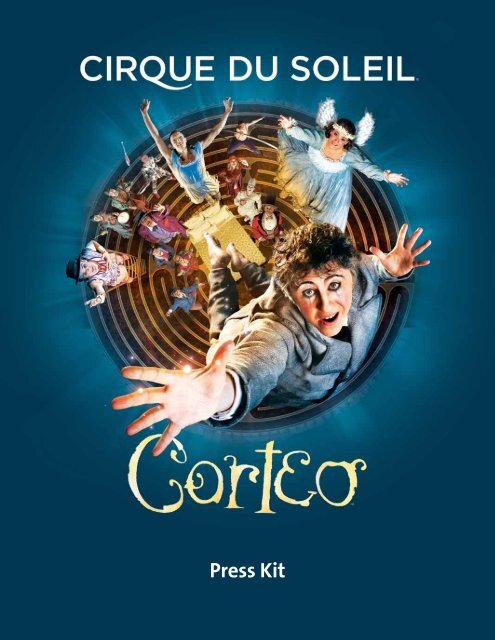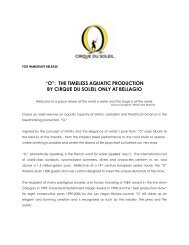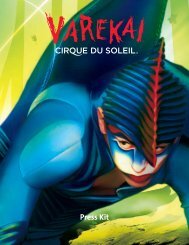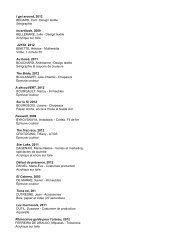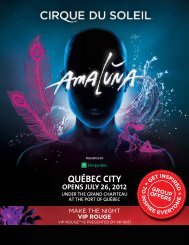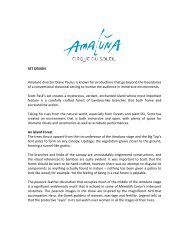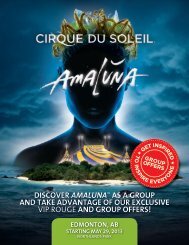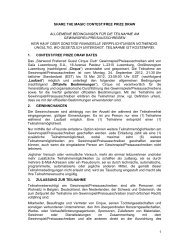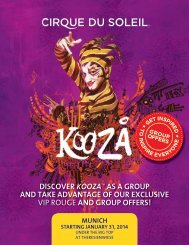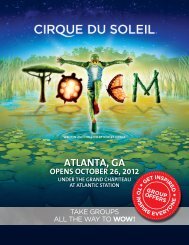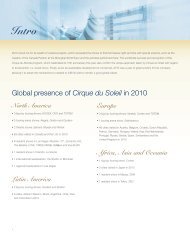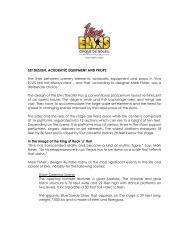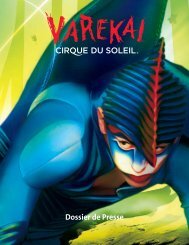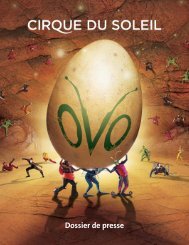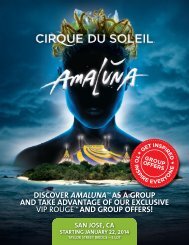Press Kit - Cirque du Soleil
Press Kit - Cirque du Soleil
Press Kit - Cirque du Soleil
You also want an ePaper? Increase the reach of your titles
YUMPU automatically turns print PDFs into web optimized ePapers that Google loves.
<strong>Press</strong> <strong>Kit</strong>
Show Overview<br />
Written and Directed by Daniele Finzi Pasca<br />
Corteo, which means “cortege” in Italian, is a joyous<br />
procession, a festive parade imagined by a clown.<br />
The show brings together the passion of the actor<br />
with the grace and power of the acrobat to plunge the<br />
audience into a theatrical world of fun, comedy and<br />
spontaneity situated in a mysterious space between<br />
heaven and earth.<br />
The clown pictures his own funeral taking place in a<br />
carnival atmosphere, watched over by quietly caring<br />
angels. Juxtaposing the large with the small, the ridiculous<br />
with the tragic and the magic of perfection with the<br />
charm of imperfection, the show highlights the strength<br />
and fragility of the clown, as well as his wisdom and<br />
kindness, to illustrate the portion of humanity that is<br />
within each of us. The music, by turns lyrical and playful,<br />
carries Corteo through a timeless celebration in which<br />
illusion teases reality.
The Acts (in alphabetical order)<br />
Acro-Duet<br />
In this beautifully choreographed dance, a<br />
couple gracefully glides through a series of<br />
acrobatic and artistic poses highlighting<br />
superior strength, balance, and rhythm.<br />
Bouncing Beds<br />
Like a gaggle of young kids playing in their<br />
grandparents’ room, six artists jump on two<br />
600-pound beds that move on rotating<br />
platforms. In a playful atmosphere, they<br />
perform acrobatic feats, each more daring<br />
than the last.<br />
Adagio Duet<br />
This masterful, tender pas-de-deux using<br />
contortion and hand-balancing is performed<br />
by a <strong>du</strong>o of little people, on a vertical ring set<br />
into a pivoting platform.<br />
Chandeliers<br />
Four women, the Dead Clown’s former loves,<br />
come together in dreamlike joy. They perform<br />
aerial acrobatics on three giant chandeliers that<br />
spin above Mauro’s bed.<br />
Artist Marionette<br />
Like a live puppet, an artist marionette suddenly<br />
appears in an innovative, rigging apparatus to<br />
play with Mauro the Dreamer Clown in a setting<br />
which evokes a beach scene from his childhood.<br />
Crystal Glasses<br />
and Tibetan Bowls<br />
Implored by Mauro the Dreamer Clown and<br />
the Giant Clown as they prepare to perform<br />
a haunting melody on crystal glasses, the Loyal<br />
Whistler, a whistling virtuoso, showcases his<br />
remarkable talent in a breathtaking performance.
Cyr Wheel<br />
Five artists perform solos and group figures on<br />
Cyr wheels. The simplicity of the Cyr wheels’<br />
line—a pure circle—sets off the intricate and<br />
energetic performance.<br />
Golf<br />
To the sound of bagpipes, a patch of green light<br />
appears, suggesting a golf course scene. The<br />
Giant Clown walks on stage, intent on giving it<br />
his best shot!<br />
Duo-Straps<br />
In this mesmerizing act, a <strong>du</strong>et uses aerial straps<br />
to create a magical and tender connection that<br />
enchants the audience with beautiful displays of<br />
agility, balance and strength.<br />
Helium Dance<br />
A tender and poetic moment between Mauro<br />
the Dreamer Clown and his little Clowness who<br />
bespells the audience with child-like delight.<br />
Foot Juggling<br />
Elegance, dexterity and coordination are wrapped<br />
up in one character who carries us away to a<br />
world tied to the traditions of old-time circus,<br />
in which Mauro and his friends once played.<br />
Juggling<br />
Four young artists perform fast-moving feats of<br />
prowess in a surprising act that blends juggling<br />
and acrobatics. With unsurpassed style, they defy<br />
the law of gravity as they juggle successively with<br />
rings, hoops and clubs.
Acrobatic Ladder<br />
A ladder specialist amazes the audience with his<br />
unnerving balance and finesse as he performs on<br />
various ladders, trying desperately to reach the<br />
angel who is watching him from above.<br />
Teatro Intimo<br />
Eight characters pile into a tiny theatre to present<br />
a wild and zany version of “Romeo and Juliet”<br />
where the unexpected awaits at every turn.<br />
Little Horses<br />
A couple of “pantomime horses,” each inhabited<br />
by two artists, give the Little Clown a hard time.<br />
By turns, the Little Horse and the Little Mare will<br />
try to break free from their trainer’s grip.<br />
Teeterboard<br />
Surrounded by two groups of artists lending<br />
rhythm to the act with their voices and<br />
percussion work, three acrobats redefine<br />
teeterboard technique in an act where speed<br />
is rivalled only by complexity.<br />
Paradise<br />
By superimposing a trampoline-like net and<br />
three Korean frame stations placed further<br />
apart from one another as never seen before,<br />
a universe is created in which high-flying and<br />
bouncing come together, as if it were the<br />
most natural thing in the world, in a single<br />
breathtaking act.<br />
Tightwire<br />
Surrounded by angels six metres above the<br />
ground, a young woman dances across a<br />
tight-wire using point shoes, a unicycle,<br />
multiple hoops and her bare feet. Then, she<br />
challenges gravity by climbing a 40-degree<br />
diagonal tight-wire to disappear into the<br />
heavens some 12 metres in the air.
Tournik<br />
A group of artists cross paths in an act which<br />
marries horizontal bar techniques with circus<br />
arts. The artists perform on a central cube-shaped<br />
structure, with two additional bars on each side<br />
of the cube. The complexity of the fright pattern<br />
and the defiance of gravity will keep you on the<br />
edge of your seat. A final farewell to Mauro.<br />
The Characters<br />
Mauro the Dreamer Clown<br />
Mauro the Dreamer Clown is the central<br />
character of the story, the one who is being<br />
honoured by this fantastic funeral … but could it<br />
all be a dream? Whith a former member of the<br />
troupe surrounding him, he dons his costume to<br />
perform onstage one last time.<br />
The White Clown<br />
For the White Clown, appearances are what<br />
matters most. Like Mr. Loyal, he is an authority<br />
figure … at least, he’d like to be. Of all the<br />
colourful characters, he admires only the stars<br />
and scorns the others. He is the one who opens<br />
the door to the magic of the circus for Mauro the<br />
Dreamer Clown.<br />
The Loyal Whistler<br />
The origins of the Loyal Whistler lie in the classic<br />
role of “Mr. Loyal,” the ringmaster of traditional<br />
circuses. The Loyal Whistler evokes images of a<br />
former military man, one who has retrained in<br />
the circus arts but never quite lost his former<br />
ways. When he starts to whistle, his boundless<br />
artistic passion comes to the fore.
The Clowness<br />
The Clowness is an actress, a veritable Grande<br />
Dame of the stage, who somehow found herself<br />
a part of this nutty troupe. Her professionalism<br />
and her strength of character allow her to bear<br />
the foolishness of her partners, whom she never<br />
fails to charm.<br />
The Little Angel<br />
The embodiment of sweetness and light, the<br />
Little Angel watches over the Dreamer Clown’s<br />
bed and acts as his guide, like Beatrice, who<br />
guided Dante through Paradise. It is the Little<br />
Angel who teaches the Dreamer Clown to fly.<br />
The Little Clown<br />
A diminutive clown who’s in love with the<br />
Clowness, the Little Clown is always ready to<br />
play tricks on his associates. Impish and lively,<br />
he is both an endearing companion and a force<br />
to be reckoned with.<br />
The August Clown<br />
The August Clown is the White Clown’s antagonist.<br />
As much as the White Clown represents order<br />
and appearances, the August Clown is the one<br />
who always messes everything up and, as a result,<br />
finds himself in the most incredible situation.<br />
The August Clown is a physical character: he is<br />
prone to falling down and his fellow stooges give<br />
him a rough ride especially the White Clown.<br />
The Giant Clown<br />
Although only an amateur opera singer, the<br />
Giant Clown imagines himself to be a great<br />
artist of worldwide renown. Without doubt,<br />
it is with him that the Dead Clown is closest,<br />
almost like brothers.
Set Design<br />
The set and decor of Corteo plunge the audience into a lyrical<br />
world, a strange area between heaven and earth.<br />
The Stage<br />
Set Designer Jean Rabasse has divided the Grand Chapiteau<br />
and its rotating stage in two, with each half of the audience<br />
facing the other half, so they see not only the performance,<br />
but also have a performer’s eye view of the audience. This is<br />
a first for <strong>Cirque</strong> <strong>du</strong> <strong>Soleil</strong>.<br />
• There are two turntables built into the stage, which is<br />
about 31.6 m long, and the track is almost 12.5 m long.<br />
• More than 9,000 images were used in the research and<br />
development phase of the set design to blend many visual<br />
styles and influences, from the baroque to the modern.<br />
The Patience<br />
The Patience is a massive arched technical structure made of<br />
steel which dominates the interior of the Grand Chapiteau.<br />
It is one of the most complex set elements in the show and<br />
is used to transport various scenic elements and pieces of<br />
acrobatic equipment on and off stage from above.<br />
• The Patience has two rails that traverse the<br />
Grand Chapiteau.<br />
• Each rail is fitted with four platform-like carts to carry<br />
the scenic and acrobatic elements.<br />
• The eight carts have a lifting capacity of 450 kg<br />
and a top speed of 1.2 m per second.<br />
• The Patience is 12.5 m above the stage at its highest point.<br />
It is entirely self-supporting and could be set up anywhere.<br />
The Curtains<br />
It was a visit to the exhibition “The Great Parade: Portrait<br />
of the Artist as a Clown” at the National Gallery of Canada<br />
that inspired Jean Rabasse to paint the Corteo Procession on<br />
the curtains. His design was influenced by the work of such<br />
painters as Willette, Picasso, Tiepolo, Pelez and Knight.<br />
• The inspiration for the show’s curtains was an<br />
1885 painting by Parisian artist Adolphe Willette.<br />
• The two enormous baroque-style “Roll Drop” curtains<br />
(17.6 m wide and almost 12 m high), and the four sidewaysopening<br />
Italian-style curtains are among the most striking<br />
scenic elements in the show. They were sewn in Canada<br />
and sent to France to be painted.<br />
• It took more than two weeks to paint each of the central<br />
curtains with watercolours.<br />
• The central curtains are attached to huge supports which<br />
contain winding motors to roll them.<br />
The Labyrinth<br />
In the centre of the circular stage is a labyrinth which<br />
precisely repro<strong>du</strong>ces the proportions and size of the classic<br />
design on the aisle floor in Chartres Cathedral.<br />
• The labyrinth incorporates a 20 cm Moebius strip painted<br />
at its centre as a symbol of infinity and continuity.
Costumes & Props<br />
To create over 260 costumes for Corteo’s cast, Costume<br />
Designer Dominique Lemieux set out to accentuate the<br />
natural beauty of the artists.<br />
• She used more than 900 different fabrics, concentrating<br />
on natural fibres such as silks, linens, cottons and lace in<br />
a subtle colour palette that includes blues, pinks, fuchsia<br />
and gold with appliquéd spangles and jewels.<br />
• Many of the fabrics were dyed and airbrushed to give them<br />
a patina of age.<br />
• Every show day, 12 to 16 hours of ironing is needed to<br />
prepare the costumes.<br />
• There are 40 angels in Corteo and 4 types of angels: Arc<br />
Angels, Little Angels, Grand Angels and Auguste Angels.<br />
• The smallest shoe size in the show is a children’s size 3<br />
and the largest is an 18 EEE.<br />
Acrobatic & Rigging Material<br />
Corteo features a variety of innovative acrobatic equipment<br />
elements that were invented at <strong>Cirque</strong> <strong>du</strong> <strong>Soleil</strong> and designed<br />
to mesh seamlessly with the set design.<br />
• The “Paradise” act brings together two circus skills that<br />
have never been combined before: the Korean Cradle and<br />
the Tramponet (a combination of trampoline and safety<br />
net). The artists are thrown between three Korean Cradle<br />
stations placed at an unprecedented distance from each<br />
other, and rebound off the Tramponet, which is 30 m long.<br />
• The “Tournik” consist of a steel frame and twin high bars<br />
mounted on the stage turntables.<br />
• The “Lustres” are giant chandeliers that float in<br />
mid-air above the stage. They are decorated with<br />
some 4,000 sparkling “jewels” and garlands of<br />
reflective acrylic spheres.<br />
• There are three custom-built ladders in the show, each<br />
designed to meet a different acrobatic demand. They<br />
include a bungee ladder and a tall ladder which is almost<br />
4.5 m high.
Creators’ Biographies<br />
Guy LALiBeRTé<br />
GuIDE AND FouNDER<br />
Guy Laliberté was born in Quebec City in 1959. An accordionist, stilt-walker and fire-eater, he<br />
founded Quebec’s first internationally renowned circus with the support of a small group of<br />
accomplices. A bold visionary, Guy Laliberté recognized and cultivated the talents of the street<br />
performers from the Fête foraine of Baie-Saint-Paul and created <strong>Cirque</strong> <strong>du</strong> <strong>Soleil</strong> in 1984.<br />
Guy Laliberté was the first to orchestrate the marriage of cultures and artistic and acrobatic<br />
disciplines that is the hallmark of <strong>Cirque</strong> <strong>du</strong> <strong>Soleil</strong>. Since 1984, he has guided the creative team<br />
through the creation of every show and contributed to elevating the circus arts to the level<br />
of the great artistic disciplines.<br />
<strong>Cirque</strong> <strong>du</strong> <strong>Soleil</strong> has become an international organization, as much in terms of its makeup<br />
as in the scope of its activities and influence. Guy Laliberté now heads an organization with<br />
activities on five continents.<br />
In October 2007, Guy Laliberté entered into a second lifetime commitment by creating<br />
ONE DROP to fight poverty around the world by providing sustainable access to safe water.<br />
This new dream stems from the knowledge that the right to water is key to the survival of<br />
indivi<strong>du</strong>als and communities all over the world and from the values which have been at the<br />
heart of <strong>Cirque</strong> <strong>du</strong> <strong>Soleil</strong> since its inception: the belief that life gives back what you have given<br />
and even the smallest gesture will make a difference.<br />
In September 2009, Guy Laliberté became the first Canadian private space explorer. His<br />
mission was dedicated to raising awareness of water issues facing humankind on planet<br />
Earth. Under the theme Moving Stars and Earth for Water, this first Poetic Social Mission in<br />
space aimed at touching people through an artistic approach: a special 120-minute webcast<br />
program featuring various artistic performances unfolding in 14 cities on 5 continents,<br />
including the International Space Station.<br />
Awards and distinctions<br />
Université Laval (Quebec) awarded an honourary doctorate to Guy Laliberté in 2008. The<br />
year before, Guy Laliberté was award the Ernst & Young Entrepreneur of the Year award<br />
for all three levels: Quebec, Canada and international. In 2004, he received the Order of<br />
Canada, the highest distinction in the country, from the Governor General of Canada. The<br />
same year, he was recognized by Time Magazine as one of the 100 most influential people<br />
in the world. In 2003, he was honoured by the Condé Nast Group as part of the Never Follow<br />
Program, a tribute to creators and innovators. In 2001, he was named a Great Montrealer by<br />
the Académie des Grands Montréalais. In 1997, Guy Laliberté received the Ordre National <strong>du</strong><br />
Québec, the highest distinction awarded by the Government of Quebec.
DAnieLe Finzi PASCA<br />
CREAToR AND DIRECToR<br />
For Daniele Finzi Pasca, Corteo represents a kind of full circle, a bringing together of all<br />
the threads of his professional career. As a young man growing up in Switzerland, he was<br />
a competitive gymnast. He went on to work in the circus, and eventually established a<br />
reputation in theatre as a writer and director.<br />
Daniele was born into a family of photographers. “Then my mother became a painter,” he<br />
says. “I grew up surrounded by images and imagery. And I put them into motion.”<br />
Perhaps the most formative event in his life was a trip he took to India, where he worked as<br />
a volunteer looking after terminally ill patients. On his return to Switzerland, he founded a<br />
company called Sunil’s Clowns, which changed its name to Teatro Sunil in 1986. Teatro Sunil<br />
is still “home,” but Daniele also travels the world, with his own pro<strong>du</strong>ctions and as a guest<br />
director with other theatre and circus companies.<br />
A prolific writer, Daniele does not restrict his creative output to the stage. He has also<br />
published Come acqua allo specchio, a collection of short stories. (The show Passo Migratore is<br />
based on one of the stories from this collection).<br />
Daniele’s lifelong fascination with clowns and clowning took root at the famed Circus Nock,<br />
where he performed in an acrobatic clown number. He has since developed a personal<br />
approach to the tradition which he has presented in courses and workshops for companies<br />
and organizations all over the world, including Canada’s National Circus School and <strong>Cirque</strong> <strong>du</strong><br />
<strong>Soleil</strong>. He also directed the highly-acclaimed <strong>Cirque</strong> Eloize shows Nomade - La nuit le ciel est<br />
plus grand et Rain - Comme une pluie dans tes yeux.<br />
Corteo is inspired by the death and funeral of a clown, and draws on a clown figure from a<br />
past long before the existence of circus—a time when clowns were not the stereotypes we<br />
know now, but far more complex characters. Daniele says the show is “situated at a strange<br />
level between heaven and earth, where the gods and humans can interact through the<br />
medium of circus.”<br />
The show’s environment takes its inspiration from many architectural sources, especially<br />
Chartres cathedral and its labyrinth, which symbolizes the journey of life for Daniele Finzi<br />
Pasca. “The labyrinth is a great voyage: To find yourself, you have to lose yourself,” he explains.<br />
Daniele Finzi Pasca was born in Lugano, Switzerland.
Line TReMBLAy<br />
DIRECToR oF CREATIoN<br />
Line Tremblay has worked in the creative world of <strong>Cirque</strong> <strong>du</strong> <strong>Soleil</strong> since the foundation of the<br />
company in 1984.<br />
Before joining <strong>Cirque</strong>, Line worked in film and television, notably as an sssistant director at<br />
Radio-Canada. Starting in 1992, she worked as Franco Dragone’s assistant in the creation of<br />
the <strong>Cirque</strong> <strong>du</strong> <strong>Soleil</strong> shows Mystère, Alegría, Quidam, “O” and La Nouba. She was also the<br />
Artistic Director of Quidam. Her close working relationship with Franco gave her an insight<br />
into the inner workings of show direction.<br />
A newcomer to the equestrian field, Line worked with Gilles Ste-Croix as his assistant in the<br />
creation of the 2000 show Cheval Théâtre. She worked with Franco Dragone once again in the<br />
creation of the Celine Dion show A New Day. She returned to <strong>Cirque</strong> <strong>du</strong> <strong>Soleil</strong> in 2003 to work<br />
on Corteo as the first woman in <strong>Cirque</strong>’s history to occupy the position of Director of Creation.<br />
The Director of Creation’s job is to pro<strong>du</strong>ce a synergy and create an atmosphere of unity in the<br />
creative team. Line also took part in the recruiting of the team, which includes several firsttimers<br />
at <strong>Cirque</strong>, and she played an active role in the casting of the artists. With the creative<br />
team in place, Line oversaw the meshing of each member’s indivi<strong>du</strong>al artistic approach with<br />
the overall creative philosophy of <strong>Cirque</strong> <strong>du</strong> <strong>Soleil</strong>.<br />
Line first fell in love with <strong>Cirque</strong> <strong>du</strong> <strong>Soleil</strong> in 1984, drawn by its freewheeling spirit, a spirit<br />
she says has never gone away. “When I was a kid I wasn’t crazy about the circus. But I<br />
discovered the childlike wonder of it in 1984. For me, the circus is the most complete art form.<br />
It addresses the audience on the visual, emotional and physical level all at the same time. I<br />
have become a child of the circus. I was destined to a life in this milieu.”<br />
Line Tremblay was born in Hull, Canada.
JeAn RABASSe<br />
SET DESIGNER<br />
DOMinique LeMieux<br />
CoSTuME DESIGNER<br />
Oscar nominee and César winner Jean Rabasse has worked extensively in dance, theatre<br />
and cinema as a set designer and decorator. He has been the resident designer for Philippe<br />
Découflé’s dance company, DCA, for more than ten years.<br />
Jean was nominated for an Academy Award and won the César for his sumptuous, elaborate<br />
designs for the 2001 film Vatel. His other film credits include Astérix, directed by Claude Zidi,<br />
The Dreamers, directed by Bernardo Bertolucci, La Cité des enfants per<strong>du</strong>s and Delicatessen<br />
directed by Caro and Jeunet, and Norman Jewison’s The Statement.<br />
Almost simultaneously, Jean Rabasse designed two <strong>Cirque</strong> <strong>du</strong> <strong>Soleil</strong> pro<strong>du</strong>ctions: Corteo and<br />
The Beatles LOVE for the Mirage Hotel in Las Vegas. He says he never likes to do the same<br />
thing twice. “I like to mix things up. My signature is to pay very close attention to the details,<br />
the colours, the surfaces, the textures. To be very meticulous about these things, and to never<br />
repeat myself.”<br />
For Corteo, Jean Rabasse and Director Daniele Finzi Pasca decided to divide the rotating<br />
stage in two, with half the audience facing the other half, so they would be able to see the<br />
performance but also have the performers’ point of view of the audience beyond.<br />
“My basic concept for the show is that the audience is entering a theatre where the same<br />
circus has been playing for 200 years,” explains Jean. “I love this idea because it allows me to<br />
mix up all kinds of styles from the baroque to the modern. But the last thing we wanted to do<br />
was recreate a kitschy old-fashioned circus, because we must have the modernity and youth<br />
of <strong>Cirque</strong>’s acrobatics and high technology, which really doesn’t exist anywhere else.”<br />
Jean Rabasse was born in Tlemcen, Algeria.<br />
Dominique Lemieux designed the costumes for all <strong>Cirque</strong> <strong>du</strong> <strong>Soleil</strong> pro<strong>du</strong>ctions between<br />
1989 and 1998. Every single show she has worked on—We Reinvent the Circus (1989),<br />
Nouvelle Expérience (1990), Saltimbanco (1992), Mystère (1993), Alegría (1994), Quidam<br />
(1996), “O”, La Nouba (1998), Corteo (2005), ZAIA (2008) and Banana Shpeel (2009)—bears<br />
her unique imprint.<br />
As a costume designer, Dominique does a lot more than simply outfit the artists. Her designs<br />
play a key role in creating the fantastic characters that populate the <strong>Cirque</strong> <strong>du</strong> <strong>Soleil</strong> universe.<br />
With an expert eye, Dominique weaves colours, patterns and fabrics into fabulous<br />
costumes. But her choice of material is not strictly guided by aesthetic considerations alone.<br />
For Dominique, determining how fibres react to skin, movement, fire or water is of vital<br />
importance, and she never loses sight of the artists’ needs.<br />
Dominique’s passion for drawing started at an early age and led her to study Fine Arts at<br />
Concordia University. After earning her degree, she worked as an art designer and children’s<br />
book illustrator. She later enrolled in the scenography program at Canada’s National Theatre<br />
School (NTS), where the courses she took in drawing and costume design took her career in a<br />
whole new direction.<br />
To create the costumes for Corteo, Dominique Lemieux wanted to accentuate the natural<br />
beauty of the artists. “The show’s theatrical approach distinguishes it from all previous <strong>Cirque</strong><br />
<strong>du</strong> <strong>Soleil</strong> shows,” she explains. “We are closer to traditional circus, in which the humanity of<br />
the artists is revealed. That translated into costumes that resemble regular street clothes.”<br />
Dominique Lemieux was born in Montreal, Canada.
DeBRA BROwn<br />
CHoREoGRAPHER<br />
JeAn-FRAnCOiS COTe<br />
CoMPoSER<br />
A virtuoso in the emotion of movement, choreographer Debra Brown, former gymnast–<br />
turned-dancer is world-renowned for her unique choreographies blending acrobatics and<br />
dance.<br />
In 1986, at a friend’s suggestion, Debra snuck into the <strong>Cirque</strong> <strong>du</strong> <strong>Soleil</strong> Grand Chapiteau<br />
<strong>du</strong>ring the intermission to catch the second half of a show. Captivated by what she saw, she<br />
discovered many parallels between <strong>Cirque</strong>’s artistic approach and her own. The following<br />
year, she joined the troupe as a choreographer for We Reinvent the Circus and went on to<br />
choreograph the shows Nouvelle Expérience, Saltimbanco, Alegría, Mystère, Quidam, “O”,<br />
La Nouba, Corteo, one act in Zumanity and ZED. Following Corteo, she created a cabaretstyle<br />
show called Line One for her own company.<br />
Ever keen to diversify and reinvent, Debra continued forging her impressive and unconventional<br />
creative path, working with artists and groups from a wide variety of disciplines. At the 1990<br />
Festival Mondial <strong>du</strong> <strong>Cirque</strong> de Demain in Paris, her work with a group of contortionists—<br />
showcasing her famous “quadruped choreography” in which four people become a vehicle—<br />
won her the Soviet <strong>Press</strong> Award for Most Outstanding Choreographer. She also choreographed<br />
John Corigliano’s opera The Ghosts of Versailles, for the world premiere presented at<br />
the Metropolitan Opera in New York and Wagner’s Ring cycle, put on by the Lyric Opera of<br />
Chicago. In 1995, she worked with Luciano Pavarotti on the Metropolitan Opera’s pro<strong>du</strong>ction<br />
of La Fille <strong>du</strong> Régiment (The Daughter of the Regiment) in New York.<br />
At the height of her international fame, Debra set her sights on the world of rock music,<br />
choreographing Aerosmith’s Jaded video and energetic performance for the American<br />
Music Awards in 2001, as well as Madonna’s Drowned world tour the same year. Debra<br />
has also worked with major musical acts such as Shakira and Wyclef Jean (2006 World<br />
Cup Soccer finals), Celine Dion and Madonna, and her film work includes Catwoman,<br />
Van Helsing and Barney’s Great Adventure.<br />
Over the years, Debra has picked up numerous prizes and awards. At the 14th Bob Fosse<br />
Awards in Los Angeles in 1997, she received the Innovative Choreography Award in honour<br />
of her exceptional contribution to choreography and dance. In 2002, she received an Emmy<br />
for her choreography of an act created by <strong>Cirque</strong> <strong>du</strong> <strong>Soleil</strong> for the Academy Awards.<br />
Debra Brown was born in Brantford, Canada.<br />
A self-taught keyboard player, composer and prolific electronic musician since the 1980s, Jean-<br />
François Côté is very active on the LA music scene. He has also worked with many of Quebec’s<br />
leading singers and trailblazing groups. He is known for mixing existing styles seamlessly with<br />
electronic music to invent new forms.<br />
Jean-François was a promising hockey player as an adolescent, but he discovered his true<br />
calling at the age of 16 when he started playing keyboards with rock and soul groups on<br />
the Montreal music scene, developing sounds and a style that were uniquely his own.<br />
At the same age he got a job as a security guard for the very first <strong>Cirque</strong> <strong>du</strong> <strong>Soleil</strong> show.<br />
“At night,” he recalls, “I would sneak behind René Dupéré’s keyboard to make music and<br />
polish my technique.”<br />
Years later, Jean-François was playing keyboards for singer Julie Masse and was noticed by<br />
<strong>Cirque</strong> <strong>du</strong> <strong>Soleil</strong> composer Benoit Jutras. That encounter led to his first formal association with<br />
the company as Musical Director and Con<strong>du</strong>ctor for <strong>Cirque</strong> shows “O” and Mystère. He also<br />
created the sound design for the Taiko drum sequence in the <strong>Cirque</strong> Imax film Journey of Man.<br />
Jean-François says <strong>Cirque</strong> is one of the most stimulating environments in which to work as a<br />
composer. “ In spite of its size, <strong>Cirque</strong> has remained true to its primary vocation: the creation<br />
of quality shows. The liberty they give to the creators is unequalled.”<br />
Jean-François Côté was born in Montreal, Canada.
PhiLiPPe LeDuC<br />
CoMPoSER AND<br />
MuSICAL DIRECToR<br />
MARiA BOnzAniGO<br />
CoMPoSER AND<br />
MuSICAL DIRECToR<br />
Composer, arranger and con<strong>du</strong>ctor Philippe Le<strong>du</strong>c describes himself as a workaholic, and<br />
that is borne out by the sheer volume of his work. His compositions and arrangements have<br />
literally been part of the background music of daily life in Quebec since the early 1980s.<br />
Philippe has been in demand as a composer of advertising jingles for a wide variety of national<br />
and international accounts. But as prolific as he has been for commercial clients, he has<br />
always made time for his own compositions.<br />
Philippe describes his orchestral score for Corteo as “very visceral music,” but he is quick to<br />
add that there are many ethereal passages and passionate moments, too.<br />
“I started with the physical,” he says. “There is a relationship between the movements of the<br />
performers and the music. In a very broad sense, the music is operatic. I’m trying to stretch the<br />
musical spectrum at <strong>Cirque</strong>.”<br />
Philippe sees Corteo as a show full of contrasts and musical moods, from solo guitar to an<br />
imposing orchestral presence. “It’s very beautiful at the end,” he says, “but along the way<br />
it’s funny, too. There are surprises and laughter around every corner. There are medieval<br />
influences with ancient instruments and traces of the 1930s but it’s all very current music.”<br />
Philippe Le<strong>du</strong>c was born in Montreal, Canada.<br />
Maria Bonzanigo has worked closely with Corteo Director Daniele Finzi Pasca since joining his<br />
company Teatro Sunil in 1984 (before it was even known by that name). Her music has been<br />
integral to many of the Sunil’s best-known shows, including Te Amo and Tres Tristes Tangos.<br />
Maria has also appeared in Sunil pro<strong>du</strong>ctions as an actress and dancer, and has worked as a<br />
director and choreographer too, for her own music and for other composers’ works.<br />
“Working with Daniele Finzi Pasca for more than 20 years, we created a language together,”<br />
says Maria. “A way to communicate intimately with the audience and the music is an integral<br />
part of that language.”<br />
For Corteo, Maria Bonzanigo is sharing the <strong>du</strong>ties of composer with Philippe Le<strong>du</strong>c. She has<br />
been concentrating on the portion of the music that is performed by the artists in the show,<br />
while Philippe has been developing the orchestral soundtrack compositions.<br />
“We’re taking artists and acrobats and putting them in a show that is more theatre than<br />
circus,” explains Maria. “The music reflects that theatrical aspect of the show. The style is<br />
a kind of modern/medieval, with African, Asian and Latin American rhythms. It’s new and<br />
simple at the same time.”<br />
Maria Bonzanigo was born in Lausanne, Switzerland.
MARTin LABReCque<br />
LIGHTING DESIGNER<br />
JOnAThAn DeAnS<br />
SouND DESIGNER<br />
Martin’s professional credits include around 100 theatrical pro<strong>du</strong>ctions. He made his debut<br />
at <strong>Cirque</strong> <strong>du</strong> <strong>Soleil</strong> with Corteo in 2005 which he followed with KOOZA in 2007 and more<br />
recently Viva ELVIS.<br />
Before coming to <strong>Cirque</strong> <strong>du</strong> <strong>Soleil</strong>, Martin Labrecque created the lighting for two acclaimed<br />
circus shows pro<strong>du</strong>ced by <strong>Cirque</strong> Eloize, Rain and Nomade, directed by Daniele Finzi Pasca.<br />
Martin is therefore familiar with Daniele Finzi Pasca’s humanist and poetic world view, and<br />
that’s why he is seeking to bring out the emotional dimension of Corteo through his lighting.<br />
“My first intention is to highlight the emotion—the subtext—of the show,” he says.<br />
In a subtle balance of traditional techniques and modern overtones, Martin’s design evokes<br />
the ambience of a more traditional circus combined with a playful contemporary spirit.<br />
“I’m using chandeliers, footlights and flashlights in a panoply of isolated lighting effects to<br />
create an intimate atmosphere for the show,” he explains. “And I’m using lateral lighting as<br />
the basis of the concept. That’s because the division of the stage in two—which is a first for<br />
<strong>Cirque</strong> <strong>du</strong> <strong>Soleil</strong>—more or less dictates the lighting setup for Corteo.”<br />
Martin Labrecque was born in Montreal, Canada.<br />
Jonathan Deans, one of the most sought-after sound designers in the musical theatre world,<br />
is the man behind the sound environments of Corteo. Having created the soundscapes of<br />
Saltimbanco, Mystère, “O”, La Nouba, ZUMANITY, KÀ, The Beatles LOVE, KOOZA, Wintuk, OVO,<br />
CRISS ANGEL Believe and, most recently, Viva ELVIS, Jonathan finds <strong>Cirque</strong>’s work-in-progress<br />
and team-oriented creative approach highly stimulating.<br />
At 15, he joined the Royal Shakespeare Company as an actor where his keen interest in sound<br />
began to blend with a theatrical context. Several years later, after a spell as a sound engineer<br />
in the music in<strong>du</strong>stry, notably at Morgan Studios where he brushed shoulders with artists<br />
such as Cat Stevens, Paul Simon and Rick Wakeman, he made his way back to the theatre via<br />
the Royal Opera House, Covent Garden, and later went on to mix the sound for the musical A<br />
Chorus Line. One success soon followed another and he became the sound mixing engineer<br />
for over a dozen pro<strong>du</strong>ctions including Evita, Cats, Bugsy Malone and The Sound of Music.<br />
Jonathan’s success as a mixing sound engineer led to him being hired as sound designer<br />
on the musical Marilyn. This was followed by work on other West End shows including<br />
Time, Les Misérables, Mutiny, Jean Seberg and then on Broadway, Ragtime, Fosse, King<br />
David, Damn Yankees, Taboo, Brooklyn, Lestat, Pirate Queen and Young Frankenstein.<br />
For Jonathan Deans, <strong>Cirque</strong>’s permanent theatres and its Grand Chapiteau are two quite<br />
different worlds when it comes to sound design. “There are different technical demands, but<br />
as far as the texture and the layering of the music and sound are concerned, it’s the same,”<br />
he says. “My work is to create a unique environment for every pro<strong>du</strong>ction. And whatever<br />
the environment is, I need to make sure that sonically the audience members know they are<br />
entering a different world.”<br />
The innovative staging of Corteo posed a real challenge for Deans because the set, the<br />
performance space and the audience are split in two with a 360-degree seating plan. He had<br />
to ensure that the general sound is in perspective to what each section of the audience is<br />
viewing—and that called upon all his skills and experience.<br />
Jonathan Deans was born in England and lives in the New York area.
huGO GARGiuLO<br />
& AnTOniO VeRGAMin<br />
ACTING CoACHES TEATRo SuNIL<br />
DOLOReS heReDiA<br />
DRAMATuRGICAL ANALyST<br />
TEATRo SuNIL<br />
Acting Coaches Hugo Gargiulo and Antonio Vergamini come to Corteo from Teatro Sunil,<br />
the theatre and dance company founded by the show’s Director, Daniele Finzi Pasca in<br />
Switzerland in 1983.<br />
Motivated by a deep commitment to humanitarian principles, Daniele has placed the<br />
tragicomic figure of the clown at the core of Teatro Sunil’s pro<strong>du</strong>ctions such as Rituale,<br />
Icaro, Aittestás, Visitatio, Te Amo and Tres Tristes Tangos to express a broad range of human<br />
experiences and emotions. He has called Sunil’s emphasis on sensitivity and the sense of<br />
touch “the theatre of caress.”<br />
Hugo Gargiulo and Antonio Vergamini have been key members of the Sunil creative team<br />
as actors and directors for many years and have been working closely with all the artists<br />
of Corteo (including the musicians) to develop their acting skills and intro<strong>du</strong>ce them to<br />
the world of the clown.<br />
“Our challenge was to bring out the fragile side of the acrobats,” says Hugo, “as they are more<br />
used to putting the spotlight on their strength.”<br />
Working with a large cast has given the two coaches the opportunity to finally realize artistic<br />
dreams they have held for a long time. However, many of the artists they work with have<br />
never acted before. “Their lack of experience is a challenge,” admits Antonio. “But it also<br />
means they are more generous and ready to be open. Above all, our challenge was to bring out<br />
the fragile side of the acrobats. We would like each artist to contribute something unique.”<br />
Asked to describe the show, Hugo says there will be many dream-like images and a great deal<br />
of humanity on stage. “The artists will not be hidden by their makeup or their costumes, they<br />
will be presenting themselves to the audience,” he adds. “We wanted the audience to see in<br />
their faces the children they once were and the old people they will become.”<br />
Hugo Gariulo was born in Uruguay.<br />
Dolores Heredia was born in Mexico.<br />
Antonio Vergamini was born in Italy.
DAnny zen<br />
ACRobATIC RIGGING<br />
DESIGNER<br />
nAThALie GAGné<br />
MAKEuP DESIGNER<br />
Danny Zen first arrived at <strong>Cirque</strong> <strong>du</strong> <strong>Soleil</strong> in 1990 to work as a welder in the company’s<br />
workshops.<br />
Danny went on the first European tour of <strong>Cirque</strong> Réinventé in 1990, then moved on to Nouvelle<br />
Expérience, the first show he worked on as a rigger. He toured with Saltimbanco in 1992 as a<br />
tent technician. He was chief rigger for Quidam in 1996 and, as head technician for <strong>Cirque</strong>’s<br />
Creation Studio, he contributed his expertise to the creation of Alegría, Mystère, Quidam,<br />
Dralion, Varekai, “O”, La Nouba and KÀ.<br />
Because he is involved in the design and creation of the equipment in Corteo, Danny Zen<br />
sees the work of the rigger as more than mechanical. “It is creative in its own way,” he says.<br />
“We have to work closely with the set designer to create new equipment—such as the<br />
lustre—which are acrobatic devices and at the same time, set elements. That calls for a<br />
marriage between technological requirements and the artistic demands of the show.<br />
Danny is constantly aware of the need for safety as the first priority for any piece of<br />
equipment or set element used by the artists and has worked to develop the safety standards<br />
in use throughout <strong>Cirque</strong>’s pro<strong>du</strong>ctions. He has also been active in the training of all riggers<br />
for the company. “The riggers are the people closest to the artists,” he explains. “They’ve got<br />
the artists’ lives in their hands.”<br />
Makeup Designer Nathalie Gagné has been fascinated by makeup and its influence on the<br />
actor’s craft since her teens. She studied theatre pro<strong>du</strong>ction at Cégep de Saint-Hyacinthe,<br />
a community college in Quebec, then went on to become one of the first gra<strong>du</strong>ates of the<br />
Montreal subsidiary of the famed Paris-based makeup school École Christian Chauveau.<br />
Before joining <strong>Cirque</strong> <strong>du</strong> <strong>Soleil</strong>, Nathalie worked in theatre, film and television.<br />
Since <strong>Cirque</strong> performers have to apply their own makeup, Nathalie involves them in the actual<br />
creation of their onstage look. “Unlike actors, acrobats aren’t used to studying their own<br />
faces,” she says. “One of my goals is to get them to do just that, and help them find within<br />
themselves what I call ‘lines of force’ that will serve to build their characters.”<br />
“Makeup is a reflection of the character’s soul. It’s also a magic wand that sweeps away<br />
inhibitions,” says Nathalie, who since 1995 has crafted more than 1,000 makeup designs for<br />
<strong>Cirque</strong>, choosing her final concepts from over 5,000 sketches.<br />
Nathalie is also responsible for ensuring the integrity of all makeup designs that bear her<br />
signature. Since the performers apply their own makeup, workshops in makeup techniques<br />
are now part of the general training provided to <strong>Cirque</strong> <strong>du</strong> <strong>Soleil</strong> artists. Nathalie first teaches<br />
performers how to do their own makeup, and then writes a step-by-step application guide for<br />
each of them.<br />
Nathalie intro<strong>du</strong>ced new makeup concepts to the shows Mystère, Alegría and Saltimbanco,<br />
which led her to work with Director Franco Dragone and Costume Designer Dominique<br />
Lemieux. Following her work on Quidam, “O”, La Nouba, Varekai, Zumanity, KÀ, Corteo,<br />
DELIRIUM, LOVE, ZAIA and CRISS ANGEL Believe, Nathalie added a 15th contribution to the<br />
creation of a <strong>Cirque</strong> <strong>du</strong> <strong>Soleil</strong> show with Viva ELVIS.<br />
Nathalie Gagné took an entirely different approach to create the urban/romantic characters<br />
in Corteo. “I had to delve into the emotions of the artists, to find their true nature,” she<br />
explains. “We didn’t created fictional characters as we did for all previous shows. For Corteo,<br />
the characters emerged from the artists’ own faces, thanks to the makeup.”<br />
This methodology corresponds to the humanist approach taken by the show’s director, Daniele<br />
Finzi Pasca, especially when it involves the clowns. “According to Daniele, most children are<br />
afraid of clowns,” says Nathalie. “But children will want to hug the clowns in Corteo.”
Fast Facts<br />
The Show:<br />
• Corteo first premiered in Montreal in 2005. Since then<br />
the show has visited more than 41 cities in more than<br />
7 different countries around the world.<br />
• Corteo celebrated its 1,000th performance in January 2008<br />
in San Diego, uSA; its 1,500th in June 2009 in Nagoya,<br />
Japan; its 2,000th performance in September 2010 in<br />
Kazan, Russia; and its 2 500th performance in January<br />
2012 in barcelona, Spain.<br />
• As with all <strong>Cirque</strong> <strong>du</strong> <strong>Soleil</strong> pro<strong>du</strong>ctions,<br />
no animals perform in Corteo.<br />
• More than 6.5 million people have been enthralled<br />
by the world of Corteo*.<br />
Cast and Crew:<br />
The cast and crew is an international one, representing the<br />
following 25 nationalities (the cast is from the 20 countries<br />
indicated in bold): Argentina, Armenia, Australia, belarus,<br />
belgium, brazil, Canada, China, France, Germany, Ireland,<br />
Italy, Japan, Kazakhstan, Netherlands, Poland, Portugal,<br />
Romania, Russia, Singapore, Spain, ukraine, uzbekistan,<br />
united Kingdom and united States.<br />
• Although you will generally hear French and English<br />
spoken on-site, many other languages are spoken: Italian,<br />
Portuguese, Russian and more.<br />
• About 160 employees travel with the tour<br />
(including 62 performers).<br />
• The tour relies on local suppliers for many essentials such as<br />
food, bio-diesel fuel, dry ice, machinery, food & beverages<br />
for patrons, banks, delivery services, recycling, and waste<br />
management—thereby injecting significant money into the<br />
local economy.<br />
• During an engagement in a city, over 150 people are hired<br />
locally for a variety of jobs including ticket takers, ushers,<br />
janitors, receptionists, etc.<br />
• The kitchen employs 1 kitchen manager and 3 cooks.<br />
• Two performance medicine people (1 physiotherapist<br />
and 1 therapist) travel with the tour.
Village on wheels<br />
<strong>Cirque</strong> <strong>du</strong> <strong>Soleil</strong>’s mobile village includes the Grand Chapiteau (big Top), one large entrance tent, artistic tent, box office, kitchen,<br />
school, offices, warehouses and more. Completely self-sufficient for electrical power, the site relies only on a local water supply<br />
and telecommunication facilities to support its infrastructure.<br />
A marvel on its own, <strong>Cirque</strong> <strong>du</strong> <strong>Soleil</strong> has four other such “villages on wheels” currently touring: KooZA, oVo, ToTEM and Varekai.<br />
The Site<br />
• The site takes 8 days to set up and 3 days to deconstruct.<br />
• A total of 65 trailers are needed to transport the<br />
1,200 tons of equipment that Corteo carries around.<br />
A few of these trailers are used <strong>du</strong>ring the season as<br />
storage spaces, kitchen and workshops.<br />
• 2 to 3 generators provide electricity to the<br />
Grand Chapiteau and the entire set-up.<br />
• The Grand Chapiteau, the artistic tent and the<br />
Tapis Rouge tent are entirely climate controlled.<br />
The Grand Chapiteau<br />
• The seating capacity of the Grand Chapiteau<br />
is approximately 2,600.<br />
• Conceived by a team of Canadian engineers, the canvas<br />
was pro<strong>du</strong>ced by a French company who specializes in<br />
sails and big tops: Les Voileries <strong>du</strong> Sud-ouest.<br />
• The canvas for the tent and its 11 tunnels weigh<br />
approximately 11 500 pounds.<br />
• The Grand Chapiteau is 66 feet high and has a diameter<br />
of 167 feet.<br />
• The 4 masts stand at 80 feet above the ground.<br />
The entrance Tent<br />
• A large entrance tent holds the merchandise, food<br />
and beverage counters.<br />
The Tapis Rouge Tent<br />
• The Tapis Rouge tent hosts up to 250 guests<br />
and is available for private functions.<br />
The Artistic Tent<br />
• The artistic tent includes a wardrobe area, dressing rooms,<br />
a fully equipped training area and a physiotherapy room.<br />
The <strong>Kit</strong>chen<br />
• The kitchen is the heart of the village – not only does it<br />
serve between 200-250 meals per day, six days a week<br />
it is also the meeting place for cast and crew alike.
At a Glance<br />
From a group of 20 street performers at its beginnings in<br />
1984, <strong>Cirque</strong> <strong>du</strong> <strong>Soleil</strong> is a major Québec-based organization<br />
providing high-quality artistic entertainment. The company<br />
has 5,000 employees, including more than 1,300 artists from<br />
close to 50 different countries.<br />
<strong>Cirque</strong> <strong>du</strong> <strong>Soleil</strong> has brought wonder and delight to more than<br />
100 million spectators in more than 300 cities in over forty<br />
countries on six continents. <strong>Cirque</strong> <strong>du</strong> <strong>Soleil</strong> International<br />
Headquarters are in Montreal, Canada.<br />
For more information about <strong>Cirque</strong> <strong>du</strong> <strong>Soleil</strong>, visit<br />
www.cirque<strong>du</strong>soleil.com<br />
The mission<br />
The mission of <strong>Cirque</strong> <strong>du</strong> <strong>Soleil</strong> is to invoke the imagination,<br />
provoke the senses and evoke the emotions of people<br />
around the world.<br />
The creation of <strong>Cirque</strong> <strong>du</strong> <strong>Soleil</strong><br />
It all started in baie-Saint-Paul, a small town near Québec<br />
City in Canada. There, in the early eighties, a band of<br />
colourful characters roamed the streets, striding on stilts,<br />
juggling, dancing, breathing fi re, and playing music. They<br />
were Les Échassiers de baie-Saint-Paul (the baie-Saint-Paul<br />
Stiltwalkers), a street theatre group founded by Gilles<br />
Ste-Croix. Already, the townsfolk were impressed and<br />
intrigued by the young performers – including Guy Laliberté<br />
who founded <strong>Cirque</strong> <strong>du</strong> <strong>Soleil</strong>.<br />
The troupe went on to found Le Club des talons hauts (the<br />
High Heels Club), and then, in 1982, organized La Fête<br />
foraine de baie-Saint-Paul, a cultural event in which street<br />
performers from all over met to exchange ideas and enliven<br />
the streets of the town for a few days. La Fête foraine was<br />
repeated in 1983 and 1984. Le Club des talons hauts<br />
attracted notice, and Guy Laliberté, Gilles Ste-Croix and their<br />
cronies began to cherish a crazy dream: to create a Québec<br />
circus and take the troupe travelling around the world.<br />
In 1984, Québec City was celebrating the 450 th anniversary<br />
of Canada’s discovery by Jacques Cartier, and they needed<br />
a show that would carry the festivities out across the<br />
province. Guy Laliberté presented a proposal for a show<br />
called <strong>Cirque</strong> <strong>du</strong> <strong>Soleil</strong> (Circus of the Sun), and succeeded in<br />
convincing the organizers. And <strong>Cirque</strong> <strong>du</strong> <strong>Soleil</strong> hasn’t<br />
stopped since!<br />
A Few STATiSTiCS<br />
• In 1984, 73 people worked for <strong>Cirque</strong> <strong>du</strong> <strong>Soleil</strong>. Today,<br />
the business has 5,000 employees worldwide,<br />
including more than 1,300 artists.<br />
• At the Montréal International Headquarters alone,<br />
there are close to 2,000 employees.<br />
• More than 100 types of occupations can be found<br />
at <strong>Cirque</strong>.<br />
• The company’s employees and artists represent close<br />
to 50 nationalities and speak 25 different languages.<br />
• More than 100 million spectators have seen a<br />
<strong>Cirque</strong> <strong>du</strong> <strong>Soleil</strong> show since 1984.<br />
• Close to 15 million people will see a <strong>Cirque</strong> <strong>du</strong> <strong>Soleil</strong><br />
show in 2012.<br />
• <strong>Cirque</strong> <strong>du</strong> <strong>Soleil</strong> hasn’t received any grants from<br />
the public or private sectors since 1992.
In 2012, <strong>Cirque</strong> <strong>du</strong> <strong>Soleil</strong><br />
will present twenty-one<br />
different shows around<br />
the world:<br />
North America<br />
North America<br />
Europe Europe<br />
North America/Europe<br />
Europe Japan/North America North America/Australia<br />
TOURING SHOWS IN ARENAS<br />
TOURING SHOWS<br />
UNDER THE BIG TOP<br />
South America<br />
North America
North America<br />
Walt Disney World ® Resort<br />
in orlando, Florida<br />
ARIA Resort & Casino<br />
at CityCenter,<br />
in Las Vegas<br />
RESIDENT SHOWS<br />
Treasure Island<br />
in Las Vegas<br />
MGM Grand<br />
in Las Vegas<br />
Russia/North America<br />
bellagio<br />
in Las Vegas<br />
The Mirage<br />
in Las Vegas<br />
Kodak Theatre<br />
in Los Angeles<br />
New york-New york<br />
Hotel & Casino<br />
in Las Vegas<br />
TM Luxor<br />
in Las Vegas<br />
<strong>Cirque</strong> <strong>du</strong> <strong>Soleil</strong>, Sun Logo, Saltimbanco, Alegría, Dralion, Quidam, Varekai, Corteo, KOOZA, OVO, TOTEM, Amaluna, Mystère, “O”, Zumanity – the Sensual Side of <strong>Cirque</strong> <strong>du</strong> <strong>Soleil</strong>, La Nouba, KÀ, Zarkana, IRIS – A Journey Through the World of Cinema are trademarks<br />
owned by <strong>Cirque</strong> <strong>du</strong> <strong>Soleil</strong> and used under license. The trademark LOVE is owned by The <strong>Cirque</strong> Apple Creation Partnership and used under license. The Beatles is a trademark owned by Apple Corps Limited. The trademarks CRISS ANGEL and Believe are owned<br />
by Criss Angel and used under license. Viva ELVIS is a trademark owned by Elvis Presley Enterprises, Inc. and used under license. © The <strong>Cirque</strong> EPE Partnership. Elvis name and likeness used under license. Michael Jackson THE IMMORTAL World Tour is a trademark<br />
owned by <strong>Cirque</strong> Jackson I.P., LLC. Trademarks used under license. The Michael Jackson name, image, likeness and associated trademarks and logos are owned by Triumph International, Inc. and used under license. © 2010 <strong>Cirque</strong> Jackson I.P., LLC.
ON STAGE OR BACKSTAGE<br />
IT’S YOUR TURN TO BE PART OF THE SHOW<br />
/jobs


